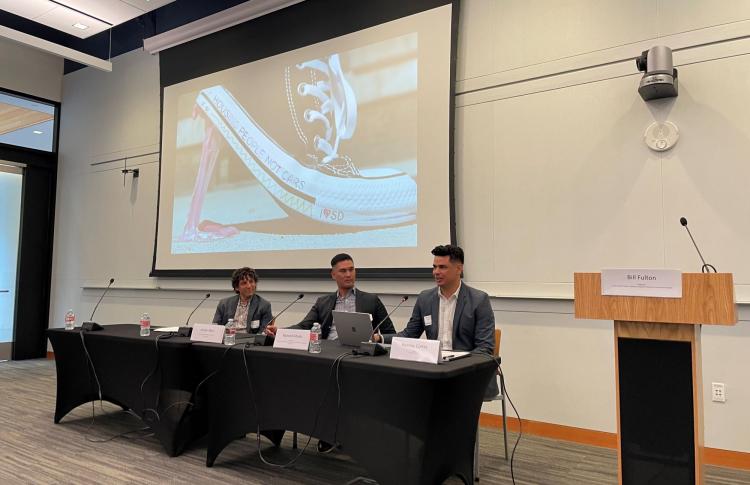
Bay Area planners and housing practitioners joined speakers from the California Department of Housing and Community Development (HCD), Bay Area and San Diego planners and other housing professionals to talk about ADUs, state housing legislation and the 6th Cycle Housing Element at Best Practices to Implement SB 9 and Missing Middle Housing on Sept. 13.
This daylong conversation addressed missing middle housing strategies and HCD’s approach to this and future Housing Element Cycles, as well as SB 9 and effective strategies for creating small-scale housing developments that advance equity.
This gathering was co-hosted by ABAG’s Regional Housing Technical Assistance Program, the Terner Center for Housing Innovation and the San Francisco Foundation.
The panelists discussed innovative zoning, ideas for improving planning processes and strategies for getting credit for missing middle housing from the state. The engaging presentations and audience questions spurred conversations that lasted over lunch and into the end of the day. A notable highlight was the conversation during the last panel with HCD representative Megan Kirkeby. More information about the panels is outlined below.
The day’s program included three panels:
Making It Feasible: Innovative Zoning and Land Use Approaches from the Bay Area and Beyond. Panelists included Raynard Abalos, Deputy Director, Department of Land Development Review Division, Development Services Department, City of San Diego; Jordan Klein, Director, Department of Planning and Development, City of Berkeley; Rammy Cortez, Founder, Rammy Urban Infill; and moderator Bill Fulton, Terner Center Fellow and Publisher of the California Planning & Development Report.
Making It Easy: New Ideas for Improving Planning Processes. Panelists included Renée Schomp, Director, Napa Sonoma ADU Center; Annie Fryman, Director of Cities, Abodu; Avery Stark, Associate Planner, City of Milpitas; and moderator David Garcia, Terner Center Policy Director.
Making It Count: Strategies to Receive Credit for Missing Middle Housing for Housing Element Submissions, with panelists Megan Kirkeby, Deputy Director of Housing Policy Development, California Department of Housing & Community Development; David Driskell, Principal at Baird + Driskell Community Planning; and moderator Ben Metcalf, Terner Center Managing Director.
These two panels looked at specific jurisdiction policies and local and regional tools and resources that simplify processes and streamline programs to more easily construct ADUs and other types of housing. Key takeaways include:
- The need for jurisdictions to looks at small changes to policies as well as significant ones. Small changes to zoning controls can have a big impact.
- Jurisdictions need access to the tools and technical assistance that can simplify processes for ADU builders and building department and other government staff.
- Jurisdictions and builders need to recognize zoning as a racial justice issue
- There’s a long legacy of ADUs in BIPOC communities. Jurisdictions need to look at how to legalize those homes, not just focus on building new ones in (mostly) white, affluent areas.
- Have to look at race equity and class equity with ADUs and small housing in general, lots of programs become too complicated to help BIPOC folks. Need to simplify and streamline. Identify the problems seeking to solve with ADUs and be realistic and explicit in what we can solve.
The third panel focused on missing middle housing strategies and HCD’s approach to this Housing Element Cycle, and what they’re looking for in Elements to certify them.
With a growing statewide trend of larger single family home construction, jurisdictions need to create zoning that incentivizes multi-unit development, that is feasible and competitive in the market. As David Driskell noted, a jurisdiction’s missing middle strategy should include more than SB 9. And it should take into account that middle housing does not equal middle income housing. While middle housing is sometimes also affordable to moderate income owners, that’s not always the case. Jurisdictions need to understand this in their policy conversations, and they need to link zoning changes to programs in their Housing Element.
From the HCD perspective, Megan Kirkeby agreed that ADUs are part of the solution to the lack of middle housing in CA, as is SB 9. She said HCD is looking for a nonvacant site analysis, which should include an inventory and explanation of why the current use of nonvacant sites is not an impediment to development.
Beyond missing middle housing, Kirkeby outlined the agency’s approach to the 6th Cycle and future Housing Elements. Overall, she stressed that the Housing Element is more than RHNA. Communities also have an obligation to affirmatively further fair housing.
In drafting a Housing Element, Kirkeby recommended jurisdictions look at Housing Elements that HCD has already approved, and study how these jurisdictions have evolved since their first draft. She also suggested identifying government constraints within your jurisdiction and highlighting how new or existing policies and programs will overcome those constraints. To help Bay Area jurisdictions access information from other regions, RHTA staff have analyzed HCD comment letters and held a conversation with planning staff from Southern California and the Sacramento area.
Kirkeby also reiterated that this Housing Element is a contract between your jurisdiction and HCD, and the agency will be checking in with jurisdictions to see if their programs are working and if revisions are needed.
The full event and accompanying materials are available to view and download on this webpage.

